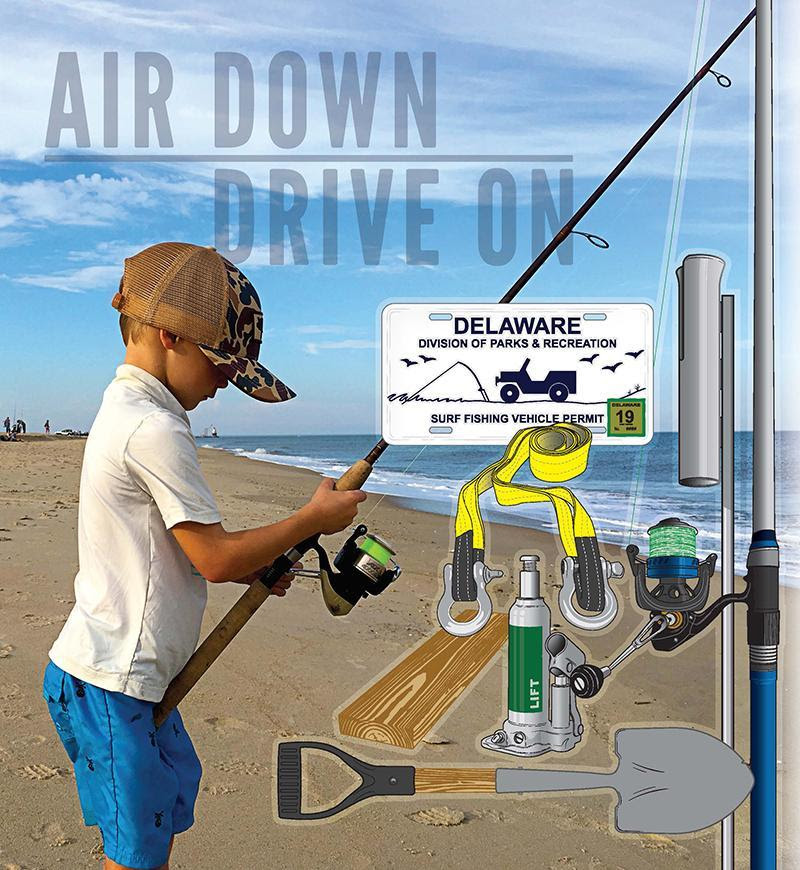Coastal Delaware Insider: Volume 1
 The amount of gear you drag across the sand can add up quickly, even for just a relaxing day on the beach. You've most likely tried hauling everything in one trip, looking more like a Sherpa than the care-free beachgoer you had planned for your next Instagram post. Beach carts are great, but even the best model, loaded down with every imaginable supply, has its limitations. The amount of gear you drag across the sand can add up quickly, even for just a relaxing day on the beach. You've most likely tried hauling everything in one trip, looking more like a Sherpa than the care-free beachgoer you had planned for your next Instagram post. Beach carts are great, but even the best model, loaded down with every imaginable supply, has its limitations.
To that end, my family has all but abandoned that trek at this point and opt instead for the miles of drive-on beach here along the Delaware coastline. It's not for everyone - 4-wheel drive and a bit of off-road courage is a must. However, once you get a handle on the drive-on scene, you may never go back to schlepping overpacked beach bags and sand toys across the hot sand again. As an added bonus, the kids might even learn a thing or two along the way and enjoy the great outdoors more than the latest video game.
Getting stuck in the sand or being fined for not following the rules is a sure-fire way to ruin a day on the beach. First and foremost, be sure your vehicle is up to the task. Four-wheel drive is a must and your vehicle should have at least seven inches of ground clearance. Step two: get your surf fishing permit and tags. Every vehicle must display a current beach tag when crossing the dunes. Now, be sure you've got all the gear needed to comply with state park regulations before heading out on the sand. Here's a basic rundown:
• Shovel
Don't depend on the plastic shovel and bucket the kids brought for sand castles. Get a small, sturdy shovel that can handle the job; you may need to dig out a tire or two.
• Vehicle Jack
The scissor jack that came with your truck won't be of much use once sand makes its way into the threads. Grab an inexpensive hydraulic jack instead.
• Jack Support
Maybe not be the most obvious piece of your kit, but you'll need something to provide a solid footing for your jack in the soft sand. A section of a 2"x6" board can do the trick.
Pro tip: this can also double as a cutting board for bait.
• Tire Gauge
Keep from getting stuck in the first place and air down before you drive out. Most vehicles are able to stay out of trouble by simply letting some air out to increase the surface area of each tire. Many people shoot for around 15 PSI in each tire, but consult your vehicle's manual for exact specs.
• Tow Rope
These can take several forms (ropes, straps, or cables), but make sure the one you purchase is rated well beyond the weight of your vehicle. Although a tow strap is typically the last resort for getting you out, it's required and could save you from an expensive tow truck bill.
• Fishing Gear
You must be actively fishing in order to enjoy the drive-on beaches in Delaware. As such, you'll need a few additional items including a fishing rod, tackle, bait, and a rod holder. You don't need the most expensive fishing gear, but any of the local tackle shops will be able to point you in the right direction.
As with any other endeavor, the sky is the limit when it comes to the amount of money you could potentially spend on your beach kit. Don't be intimidated by trucks fitted out with every off-road option available. In nearly every instance, a reasonably-priced piece of equipment will provide the same function as its more expensive counterpart.
Likewise, you don't have to be an off-road enthusiast or a die-hard fisherman to enjoy the drive-on beaches. The vast majority of people out on the beach with you are willing to lend a hand or dole out some helpful advice when needed.
Be respectful of others and remember to abide by the basic Leave No Trace principles (LNT.org) and
you're guaranteed a memorable day.
You're at the beach. Air down. Drive on.
See you on the sand.
Visit destateparks.com for maps, tips, and additional resources.
Check in with the crew at delaware-surf-fishing.com to keep up with everything happening in the surf.
|
